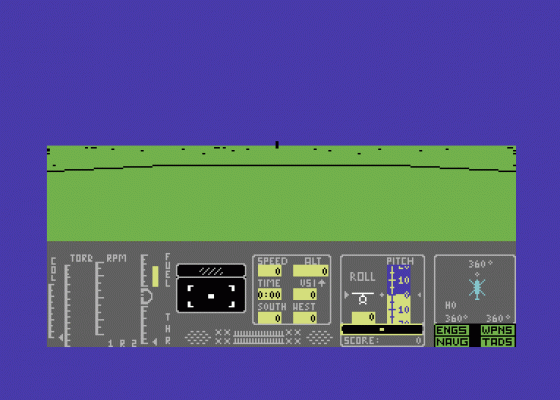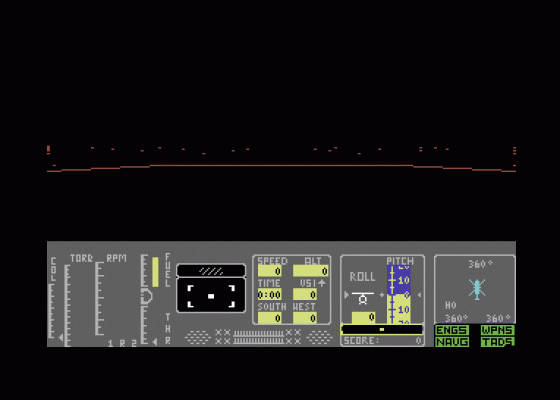
Commodore User
 1st February 1987
1st February 1987
Categories: Review: Software
Author: John Hutchinson
Publisher: Digital Integration
Machine: Commodore 64
Published in Commodore User #41
Tomahawk
I'll say it right away. Tomahawk is the best helicopter simulation I've looked at so far. The simulation is based on the US Army's AM 64A Apache Attack helicopter, a fearsome war machine that's capable of cruising at more than 180 miles per hour and carries an awesome array of weaponry.
It's obvious that a great deal of trouble has gone into making this program as authentic as possible and I'm pleased to see that the many pilots who tested and evaluated the program got a word of thanks on the program got a word of thanks on the instruction sheet - their work certainly paid off.
The instruction sheet, by the way, is clearly written and easy to follow so it's well worth reading carefully before embarking on any missions. But let's get started on the action.

Tomahawk has four major Menu options. The first is described as Flying Training and it gives you the opportunity to familiarise yourself with the helicopter and its weapons before anybody gets the chance to shoot back at you. It really is an excellent introduction.
The other three options are all Combat Missions of varying levels of difficulty. The requirements here range from destroying invading ground forces to liberating the entire map from enemy occupation. You can fly each of the missions by day or night, in clear blue skies or overcast conditions - down to a cloudbase of 50.
If that lot isn't challenging enough, you can select crosswinds and turbulence to keep you on your toes. Finally, choose the appropriate pilot rating: Trainee Pilot, Squadron Leader, Instructor or Ace.

Before lifting off, you'd better have a good look at the display in front of you. The top half of the screen shows either the terrain around you or a map display of your position in relation to the battlefront and enemy occupied territory. You're also shown the position of the nearest hostile enemy helicopter. This is particularly useful in helping you to plan your offensive.
A clearly laid out instrument panel covers the lower half of the screen. It's easy to read and contains, on the left: engine, rotor blade and torque instruments, Target Acquisition Display and vital displays of speed, pitch and altitude.
The right side contains navigation instruments: aircraft heading, bearing and track to landing pad, hostile target and navigation beacon. Finally, there's a display of the weapons at your disposal.

Of course, the weapons are what the strategic part of the game is all about. You score points for destroying targets, but the score is higher the more difficult the weapon used. The most difficult is your 30mm cannon. This is effective only within 2,000 feet but it won't knock out tanks. To use it, the target must be in your sights. The same goes for the unguided rockets of which you have 38 and which can hit targets up to 4,000 feet away.
Your eight laser-guided missiles are the most effective and easiest to use, but they won't get you many points. They'll work within three miles and you only have to 'lock-on' to the target with your laser sights, subsequent tracking of the missile is automatic - pretty nifty!
Once you've mastered all this weaponry, it's safe to lift off. This is conventional and the transition to forward flight is easily accomplished. It's possible to fly backwards and sideways as well as forwards - a very agile machine, this. But it's also quite easy to crash if you don't watch your height and rate of descent - watch out for mountain ranges too.
At speeds of more than 100mph, you can do a manoeuvre called a Torque Turn in which you change heading through 160 degrees very quickly. But don't go faster than 210mph or the rotor blades fall off. In the event of engine failure, you can autorotate the Tomahawk to a safe touchdown.
To return to base for weapons and fuel, simply key in the homing information to a landing pad and a bearing and distance will be automatically displayed. As you approach base, gently reduce speed to zero, enter the hover and slowly descend to touchdown. Nice Landing. You can also do rolling touchdowns at speeds less than 60pm. And if you land in the wrong place, you can taxi along the ground to get to the helipad.
My only criticism of this game, as a pilot, is that in order to maintain a turn, you must constantly bank the aircraft; it straightens out if you don't keep jabbing with the joystick. As a result, it's quite easy to overbank in an effort to keep the turn going - this can be disastrous.
To sum up, Tomahawk presents enough strategic and tactical problems to make the game varied and keep you interested. And the odds aren't piled too heavily against you. You've got a good chance of blasting a nice selection of enemy targets before your three choppers are turned into scrap metal.
The graphics are clear and uncluttered, and the sound effects realistic. Navigation and the tactical situation are well presented on the map display.
In all, Tomahawk is a very entertaining simulation and I had lots of fun with it.







